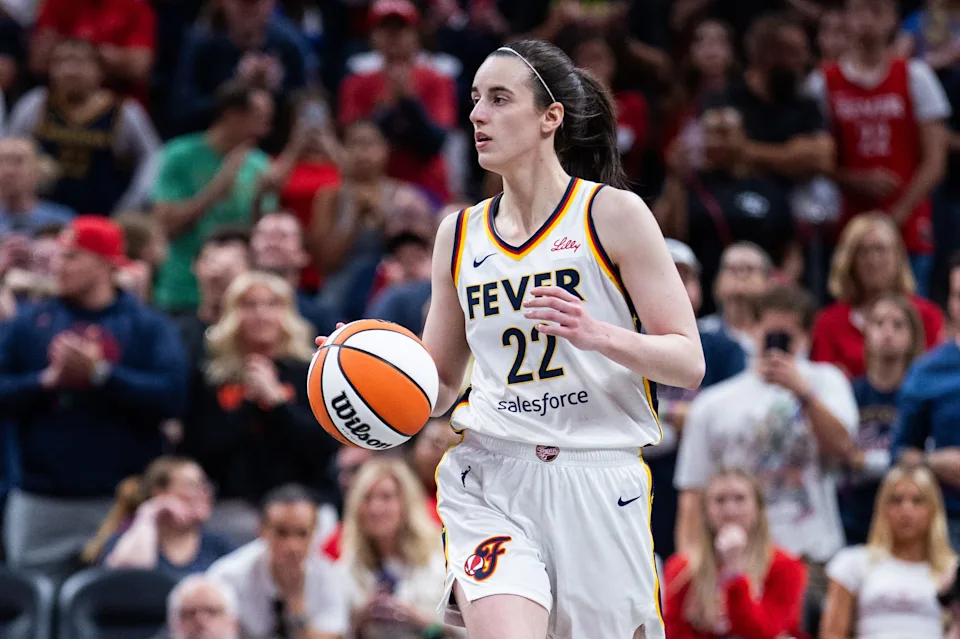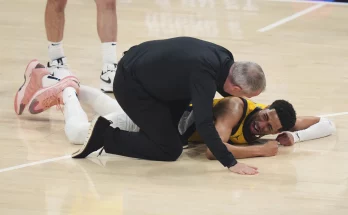Caitlin Clark, the electrifying point guard for the Indiana Fever, has been one of the most talked-about players in the WNBA since she entered the league. Known for her exceptional scoring ability, court vision, and leadership, Clark quickly became the cornerstone of the Fever’s lineup. However, in late May, she suffered a left quadriceps strain, an injury that has kept her off the court and raised questions about her return timeline and the overall impact on the team’s season.
Clark’s injury occurred during a game against the New York Liberty, where she experienced discomfort in her left quad. Although adrenaline initially masked the pain, it became clear after the game that something was wrong. Medical examinations, including an MRI, confirmed a strain in the muscle — an injury that, while not career-threatening, demands careful attention and a cautious rehabilitation approach to prevent any long-term damage.
Before the injury, Clark was playing at an incredibly high level. In her first few games of the 2025 WNBA season, she was averaging close to 20 points per game, along with solid contributions in assists and rebounds. Her playmaking skills were leading the league, and she was widely regarded as the Fever’s best hope for a playoff push. Her quickness, ball-handling, and ability to create shots for herself and teammates had put Indiana in a strong position to compete in the tough Eastern Conference.
Her absence from the lineup has undoubtedly affected the Fever. Without their star guard directing the offense, the team’s rhythm has suffered. While the Fever managed to snag some wins in her absence, including a notable victory over the Washington Mystics, the team has struggled to maintain consistency. Veteran players like Kelsey Mitchell and Aliyah Boston have stepped up to fill the void, showcasing their leadership and experience, but it’s clear that Clark’s presence on the court brings a different level of energy and threat that is hard to replace.
From Clark’s perspective, the injury has been frustrating but also a learning experience. Having been remarkably durable throughout her college and early professional career, this is her first major setback, and she has approached recovery with a measured mindset. She has been vocal about not rushing back too quickly, emphasizing the importance of proper healing over a speedy return. In interviews and team updates, Clark has expressed her commitment to following medical advice and ensuring that when she does return, she is at full strength and ready to contribute at her usual high level.
The Fever’s medical and coaching staff have been taking a cautious, methodical approach to her rehab. Recovery timelines for quadriceps strains can vary widely depending on severity, and rushing back too soon risks aggravating the injury or causing further damage. The team’s priority has been to allow Clark to heal fully through rest, physical therapy, and gradual reintroduction of basketball activities. Re-evaluations of her condition have been scheduled regularly, with plans to monitor her progress and adjust her return timetable accordingly.
As of now, Clark’s return is projected to be sometime in mid to late June, though no exact date has been confirmed. The team is hopeful that by gradually increasing her workload and managing her recovery, she could be ready to rejoin the lineup soon enough to make a meaningful impact on the remainder of the regular season. However, Clark and the Fever are both clear that health comes first, and any timeline is tentative and subject to change based on how her body responds to treatment.
While sidelined, Clark has maintained a strong leadership role off the court. Rather than isolating herself, she has stayed actively involved in team meetings, film sessions, and practices where possible. Her presence on the bench and at team gatherings has been a morale booster, and her understanding of the game allows her to provide valuable insights to both coaches and teammates. This involvement has helped the Fever maintain some continuity despite her absence and reinforces her importance not just as a player but as a team leader.
The Fever’s coaching staff has also adjusted their strategies during Clark’s recovery. Without her scoring and playmaking prowess available, the team has leaned more heavily on a balanced attack involving multiple contributors. Kelsey Mitchell, in particular, has taken on more responsibility as a scorer and floor general, while Aliyah Boston has continued to anchor the defense and provide inside presence. The team’s resilience and ability to adapt during this period will be critical as they aim to stay competitive in the Eastern Conference.
Looking ahead, the Fever have several important games on the schedule that could define their season. The return of Clark, whenever it happens, will be a huge boost in these crucial matchups. Her ability to control the tempo, create opportunities, and score from anywhere on the court makes her a game-changer. The team’s hopes for a playoff berth hinge in large part on her recovery and the ability to regain the form that made her a standout player in her rookie season.
Clark’s injury also underscores the physical toll of professional basketball. Even the most talented and conditioned athletes can face setbacks, and how they respond to adversity often defines their careers. Clark’s approach so far — cautious, disciplined, and focused on long-term health — reflects a maturity that bodes well for her future. Fans and analysts alike are eager to see her back in action, but there is broad support for her taking the necessary time to heal completely.
Beyond the immediate implications for the Fever’s season, Clark’s injury highlights the challenges WNBA players face in maintaining peak physical condition throughout a demanding schedule. The league’s level of competition continues to rise, and players are pushing their limits to excel. Recovery and injury management have become essential aspects of professional careers, and teams are investing heavily in medical staff, training, and rehabilitation programs to keep their stars on the court.
Clark’s injury also opens conversations about team depth and development. While the Fever undoubtedly miss her, the opportunity for other players to step up can be a positive development. Young players gaining experience and veterans stepping into leadership roles can help build a more balanced and resilient team. The coaching staff’s ability to nurture this growth during Clark’s absence could pay dividends down the line, complementing her eventual return and strengthening the overall squad.
Fans of the Fever and the WNBA have been showing their support for Clark during her recovery. Social media and game broadcasts have highlighted her impact on the league, and many have expressed optimism about her return. Her combination of skill, competitive fire, and charisma has made her a fan favorite and an ambassador for the sport. The hope is that once she’s back on the court, she will continue to raise the profile of women’s basketball and inspire the next generation of players.
In summary, Caitlin Clark’s injury is a significant moment in her young professional career and for the Indiana Fever’s 2025 season. While it has introduced challenges and uncertainty, the cautious and positive approach taken by Clark, the team’s medical staff, and coaching personnel provides reason for optimism. Her projected return in the coming weeks could be a pivotal moment for the Fever’s campaign, reinvigorating the team’s offense and enhancing their chances of postseason success.
Until then, the Fever will continue to adapt and fight, relying on collective effort and leadership from within. Clark’s recovery journey also serves as a reminder of the resilience and determination required to succeed at the highest levels of sport. When she does return, fans can expect her to bring the same intensity, skill, and passion that have made her one of the most exciting players to watch in women’s basketball today.



